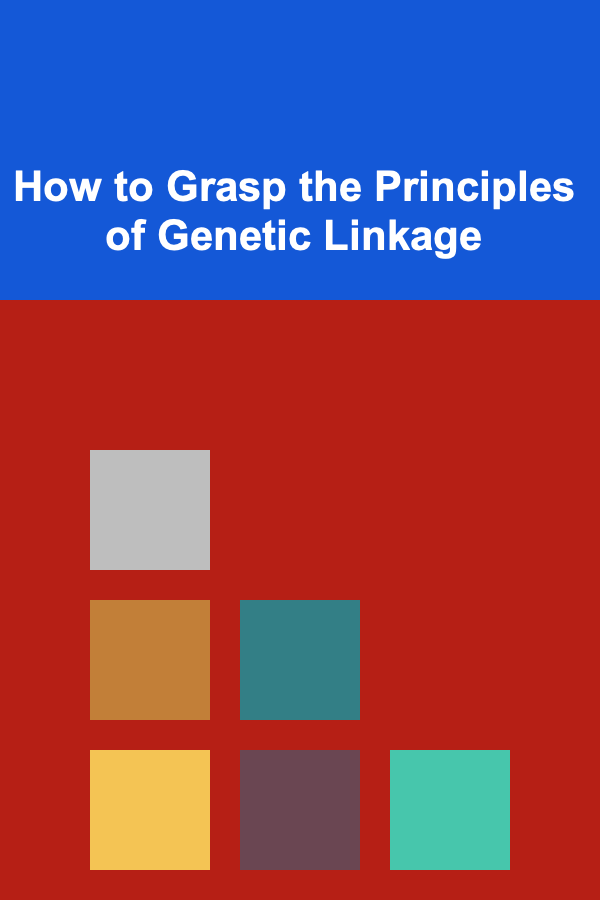
How to Grasp the Principles of Genetic Linkage
ebook include PDF & Audio bundle (Micro Guide)
$12.99$5.99
Limited Time Offer! Order within the next:

Genetic linkage is a crucial concept in the field of genetics that refers to the tendency of genes located near each other on the same chromosome to be inherited together. This concept plays a pivotal role in understanding inheritance patterns, mapping genes, and studying genetic disorders. To fully grasp the principles of genetic linkage, one must dive into the mechanics of inheritance, the factors influencing genetic recombination, and the experimental techniques used to map genes. In this article, we will break down these aspects and explore how they collectively contribute to our understanding of genetic linkage.
The Basics of Genetic Inheritance
Before delving into genetic linkage, it's important to understand the fundamental principles of genetics. Genetic inheritance is governed by the transmission of alleles, which are different versions of a gene, from parents to offspring. These alleles are carried on chromosomes, and each individual inherits a pair of chromosomes from each parent, resulting in a diploid set of chromosomes.
The basic laws of inheritance, first articulated by Gregor Mendel in the 19th century, include:
- Law of Segregation: Each individual has two alleles for each gene, and these alleles segregate during gamete formation, with each gamete receiving only one allele.
- Law of Independent Assortment: Alleles of different genes assort independently during gamete formation, which means the inheritance of one gene does not affect the inheritance of another gene.
These principles apply to genes that are located on different chromosomes or genes that are far apart on the same chromosome. However, when genes are located close to each other on the same chromosome, they tend to be inherited together, and this is where genetic linkage comes into play.
Understanding Genetic Linkage
Genetic linkage refers to the physical proximity of genes on a chromosome. When genes are linked, they do not assort independently, and instead, they are inherited together more frequently than would be expected by chance. The degree of linkage between two genes depends on the distance between them on the chromosome.
The closer two genes are to each other, the more likely they are to be inherited together. This is because the likelihood of a crossover event (which results in recombination) occurring between them during meiosis is lower. Conversely, genes that are farther apart on the same chromosome have a higher chance of recombination occurring between them, which can separate the alleles of the two genes.
In practical terms, genetic linkage is measured using recombination frequency. Recombination frequency is the proportion of offspring that inherit a recombined version of the chromosomes, which can be used to calculate the distance between two genes on a chromosome.
2.1 The Role of Meiosis in Genetic Linkage
Meiosis is the process by which gametes (sperm and egg cells) are formed. During meiosis, homologous chromosomes (chromosomes with the same genes but possibly different alleles) pair up and undergo genetic recombination, where sections of the chromosomes are exchanged. This process occurs during prophase I of meiosis.
When genes are located on the same chromosome, recombination can occur between them, but the closer the genes are to one another, the less likely they are to be separated during this exchange. This results in genetic linkage, as the genes tend to be inherited together. However, if the genes are far apart, there is a greater chance of recombination, and the genes may assort independently, following Mendel's second law of independent assortment.
2.2 Measuring Linkage
The degree of linkage between two genes is quantified using recombination frequency, which is calculated as the percentage of recombinant offspring divided by the total number of offspring. The recombination frequency (RF) is a measure of the physical distance between two genes on a chromosome.
- RF = (Number of recombinant offspring) / (Total number of offspring)
The recombination frequency is often expressed as a centimorgan (cM), where 1 cM is equal to a 1% recombination frequency. For example, if two genes have a recombination frequency of 10%, they are said to be 10 cM apart on the chromosome.
The Mechanisms of Genetic Recombination
Recombination plays a critical role in genetic linkage by reshuffling genetic material during meiosis. The process of recombination allows for the mixing of alleles between homologous chromosomes, contributing to genetic diversity. Understanding the mechanisms behind recombination is essential for grasping genetic linkage.
3.1 Crossing Over
Crossing over is the primary mechanism through which genetic recombination occurs. During prophase I of meiosis, homologous chromosomes come together to form bivalents, and they exchange segments of their chromatids. This exchange of genetic material is called crossing over.
The location of crossing over along the chromosome can be random, but the probability of crossing over occurring between two genes depends on the distance between them. The closer the genes are, the less likely they are to undergo recombination, which is why closely linked genes are inherited together more frequently than distant genes.
3.2 Chromosome Mapping
By studying recombination frequencies, scientists can construct genetic maps of chromosomes. These maps show the relative positions of genes on a chromosome based on their recombination frequencies. The concept of genetic mapping has been instrumental in understanding the structure of genomes and in identifying the location of genes associated with various traits and diseases.
Chromosome mapping can be done using a variety of techniques, such as linkage analysis, which compares the inheritance of genes in families or populations to identify patterns of co-segregation. By analyzing the recombination frequencies between pairs of genes, geneticists can determine the order and distance of genes along a chromosome.
Factors Affecting Genetic Linkage
Several factors can influence genetic linkage and the accuracy of recombination frequencies, including the following:
4.1 Distance Between Genes
As mentioned earlier, the distance between two genes is a key factor in determining the degree of genetic linkage. Genes that are close together on the same chromosome have a low recombination frequency, meaning they are more likely to be inherited together. However, as the distance between genes increases, the likelihood of recombination also increases, and the genes may assort independently.
4.2 Multiple Crossovers
In some cases, more than one crossover event can occur between two genes during meiosis. These multiple crossovers can complicate the measurement of recombination frequencies, as they may result in recombinant offspring that do not accurately reflect the true distance between genes. To account for this, geneticists may use more sophisticated techniques, such as three-point crosses or two-point linkage analysis, to accurately map genes.
4.3 Gene Interactions and Epistasis
Gene interactions can also affect the expression of traits and the inheritance patterns of genes. For example, the presence of one allele may mask the effect of another allele at a different locus, a phenomenon known as epistasis. Epistasis can influence the results of linkage studies, as it can alter the expected inheritance patterns of genes.
4.4 Chromosomal Aberrations
Chromosomal abnormalities, such as deletions , duplications , and inversions, can disrupt the normal structure of chromosomes and affect the inheritance of linked genes. These structural changes can alter the recombination frequencies between genes and lead to deviations from expected inheritance patterns.
Applications of Genetic Linkage
Understanding genetic linkage has significant implications for both basic and applied genetics. Below are some of the key applications of genetic linkage research:
5.1 Gene Mapping
One of the most important applications of genetic linkage is gene mapping. By identifying linked genes and their recombination frequencies, geneticists can create detailed maps of chromosomes and locate genes associated with specific traits or diseases. This has been particularly valuable in identifying genes responsible for inherited disorders, such as cystic fibrosis, Huntington's disease, and certain forms of cancer.
5.2 QTL Mapping
Quantitative trait loci (QTL) mapping is a technique used to identify regions of the genome associated with quantitative traits, which are traits that vary in degree rather than being discrete. By analyzing the linkage between genetic markers and traits, researchers can identify specific genetic regions that contribute to variations in traits like height, weight, and disease susceptibility.
5.3 Genetic Disease Diagnosis
Genetic linkage is also useful in the diagnosis and understanding of genetic disorders. By studying families with inherited diseases, scientists can identify linked genetic markers and use them for early detection and diagnosis. For example, linkage analysis has been used to locate the gene responsible for Duchenne muscular dystrophy and other genetic conditions.
5.4 Breeding and Agriculture
In agriculture, genetic linkage is used in marker-assisted selection (MAS) to improve crop and livestock breeding. By identifying linked markers associated with desirable traits, breeders can select individuals with the best genetic profiles, improving crop yields, disease resistance, and other traits in plants and animals.
Conclusion
Grasping the principles of genetic linkage requires an understanding of the processes of inheritance, recombination, and the factors that influence genetic transmission. By studying genetic linkage, scientists can gain valuable insights into the structure of genomes, the inheritance of traits, and the genetic basis of diseases. This knowledge is essential for advancing fields such as genetic research, disease diagnosis, and agricultural improvement.
As technology continues to advance, our ability to map and understand genetic linkage will become even more refined, allowing for greater precision in gene mapping, disease prevention, and the improvement of traits in living organisms. With these principles at the foundation of modern genetics, the possibilities for discovery and innovation in this field are virtually limitless.
Reading More From Our Other Websites
- [Home Security 101] How to Safely Disable Unused Smart Home Features to Enhance Security
- [Gardening 101] Top 10 Low‑Maintenance Perennials for a Stunning Garden All Seasons Long
- [Organization Tip 101] How to Choose the Right Dryer Vent Cleaning Kit for Your Needs
- [Home Renovating 101] How to Find Affordable Materials for Your Next DIY Home Projects
- [Hiking with Kids Tip 101] Nature Walks for All Ages: Must‑Try Day Hikes for Family Fun
- [Survival Kit 101] The Best Compact Survival Kit for Urban Apartment Dwellers Facing Power Outages
- [Home Family Activity 101] How to Organize a Family Baking Day with Creative Recipes
- [Home Holiday Decoration 101] How to Transform Your Front Porch into a Holiday Entrance
- [Home Storage Solution 101] How to Declutter and Organize Cleaning Supplies in a Small Space
- [Personal Care Tips 101] How to Choose Lip Balm to Match Your Skin Tone and Needs

Essential Guide to Affordable Options for Home Insurance and Coverage
Read More
How to Close More Deals with Effective Negotiation Strategies
Read More
How to Highlight Your Home's Best Features Through Staging
Read More
Using a Frame Alignment Tool for Bent Frames: A Comprehensive Guide
Read More
10 Tips for Protecting Archaeological Sites from Looting
Read More
How to Prepare Your Home Before Your Cruise: A Comprehensive Checklist
Read MoreOther Products

Essential Guide to Affordable Options for Home Insurance and Coverage
Read More
How to Close More Deals with Effective Negotiation Strategies
Read More
How to Highlight Your Home's Best Features Through Staging
Read More
Using a Frame Alignment Tool for Bent Frames: A Comprehensive Guide
Read More
10 Tips for Protecting Archaeological Sites from Looting
Read More